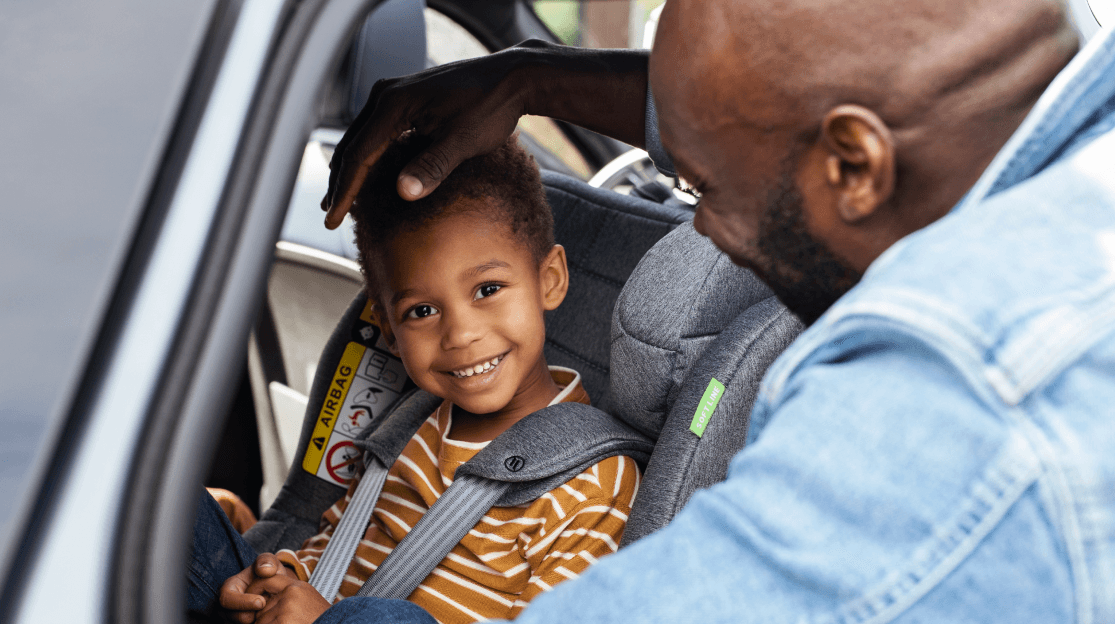
What to do when the child’s head falls in the baby seat?
The child’s head falling in the baby seat is one of the most common problems which parents face when transporting a toddler. It can look cute for a few seconds – as if the little munchkin is so tired that it is difficult for them to keep their head upright. However, this position is not only uncomfortable for the child but also dangerous, which is why today we suggest what to do when the child’s head falls in the baby seat.

Contents:
- The child’s head falling in the seat – why is it dangerous?
- What is the correct position of the child in the baby seat?
- How to secure a toddler’s head to ensure his or her proper position in the baby seat?
The child’s head falling in the seat – why is it dangerous?
There are two types of threats related to the incorrect position of the child in the baby seat. The first is related to road traffic injuries. If the baby’s head is not secured, it will not be properly protected against the overloads which operate at the time of a collision or sudden braking. The baby’s spine will then assume an incorrect position, which increases the risk of its damage even in minor road accidents. These are extremely important arguments for which you should ensure the correct position of the child in the baby seat. But that is not all; even if the road runs smoothly and calmly, the drooping head is still a threat.
In order to clarify, it is worth focusing on how much a baby’s head weighs. In the case of a newborn or infant, it is up to even 25% of the whole body weight. So, if the child weighs 10 kilograms, his head weighs as much as 2.5 kg! This is enough for the drooping head to “hug” the chest so tightly that it could cause hypoxia.
What is the correct position of the child in the baby seat?
The answer to this question depends on several factors, but it can be reduced to universal advice. First of all, the child cannot lean forward in the seat – because then, during sleep, its head will fall onto the chest. The correct position of the toddler should be a compromise between the lying and sitting position.
The angle of inclination of the baby seat is important here, although NOTE: the inclination of the baby seat does not depend on the model itself, but also on what car it will be in. The sofas of individual cars are built in different ways and tilt differently. Therefore, the correct position of the child in the baby seat is very much dependent on whether it is well suited not only to the child but also to the car. The child should sit in a position which allows the head to be kept relatively straight. The natural breathing apparatus is then not compromised.
It is also worth paying attention to other aspects of transporting a child in the baby seat. The head drop may also be affected by inappropriate clothing, thick headgear such as caps or hoods, hairstyles in the case of girls, bad seatbelt fastening or the use of inappropriate accessories to protect the child’s head in the car.
How to secure a toddler’s head to ensure his or her proper position in the baby seat?
If the baby’s head falls in the baby seat, you must implement all available means to avert the problem. However, in the case of most baby seats and their small occupiers, it is most often the case that a simple adjustment of some settings is enough to gain the correct position of the child in the baby seat.
- Choose a baby seat well for both the child and the car. This is extremely important. Car models are different and not all baby seats look the same in them. It is, therefore, advisable to try the baby seats on the couch before buying them. Attach the baby seat to the rear seat and position your small passenger in it. See how this looks, and what is the risk that it won’t hold the head properly. Look for a model which will make your child safe and comfortable.
- Position the baby seat according to the instructions, use the advice of specialists in this field. Consulting with friends does not always bring the best advice. It’s a good idea to ask someone with expertise for help. Sometimes, it is enough to slightly tilt the seat back, sometimes, it is necessary to adjust the base slightly (if you one it under the seat), or shorten / lengthen the leg which supports the base. The fact that the child’s head falls in the seat is not necessarily related to the fact that it is badly selected. Sometimes, it is enough to just change the settings.
- Watch out for clothes. In autumn and winter, always remove your child’s jacket if it is thick enough to make it difficult to fasten the seat belts correctly. Avoid hoodies and sweaters. If a child in such clothes is put into the seat – the hood should be placed over the head. This is important to avoid an unnecessary roll of material forming between the headrest and the child’s head, which increases the risk of the head falling.
- The hairdo of children with long hair is also important. If there is a protruding bob or ponytail on the back of the head (or maybe a pin which makes it uncomfortable for the child to rest the head), it is worth changing it. Sometimes, even such a small thing can make the child’s head fall.
Safe transport of a child is one of the most important elements of caring for a little person. It is on us, the parents, to organise such conditions for the child, in which the risk of an injury is as low as possible. Unfortunately, the mere purchase of any baby seat is often insufficient. The chosen model must still be very well suited to the toddler and provide them with a position which will make the journey safe and comfortable.
Related articles


